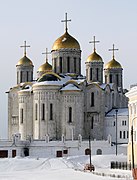Dormition Cathedral, Vladimir
You can help expand this article with text translated from the corresponding article in Russian. (December 2008) Click [show] for important translation instructions.
|

Dormition Cathedral in Vladimir (sometimes translated Assumption Cathedral) (Template:Lang-ru, Sobor Uspeniya Presvyatoy Bogoroditsy) used to be a mother church of medieval Russia in the 13th and 14th centuries. It is part of the World Heritage Site entitled White Monuments of Vladimir and Suzdal.
The cathedral was commissioned by Andrew the Pious in his capital Vladimir and dedicated to the Dormition of the Theotokos (Virgin Mary), whom he promoted as the patron saint of his lands. Originally erected in 1158-1160, the 6-pillared 5-domed cathedral was expanded in 1185-1189 to reflect the augmented prestige of Vladimir. Embracing the area of 1178 sq. meters, it remained the largest of Russian churches for the following 300 or 400 years.
Andrew the Pious, Vsevolod the Big Nest, and other rulers of Vladimir-Suzdal were interred in the crypt of this church. Unlike many other churches, the cathedral survived the great devastation and fire of Vladimir in 1239, when the Mongol hordes of Batu Khan took hold of the capital.
The exterior walls of the church are covered with elaborate carvings. The interior was painted in the 12th century and then repainted by the great Andrei Rublev and Daniil Chernyi in 1408. The Dormition Cathedral served as a model for Aristotele Fioravanti when he designed the eponymous cathedral in the Moscow Kremlin in 1475-1479. A lofty belltower, combining genuinely Russian, Gothic, and Neoclassical influences, was erected nearby in 1810.
Gallery
External links
 Media related to Cathedral of the Dormition of the Theotokos (Vladimir) at Wikimedia Commons
Media related to Cathedral of the Dormition of the Theotokos (Vladimir) at Wikimedia Commons





